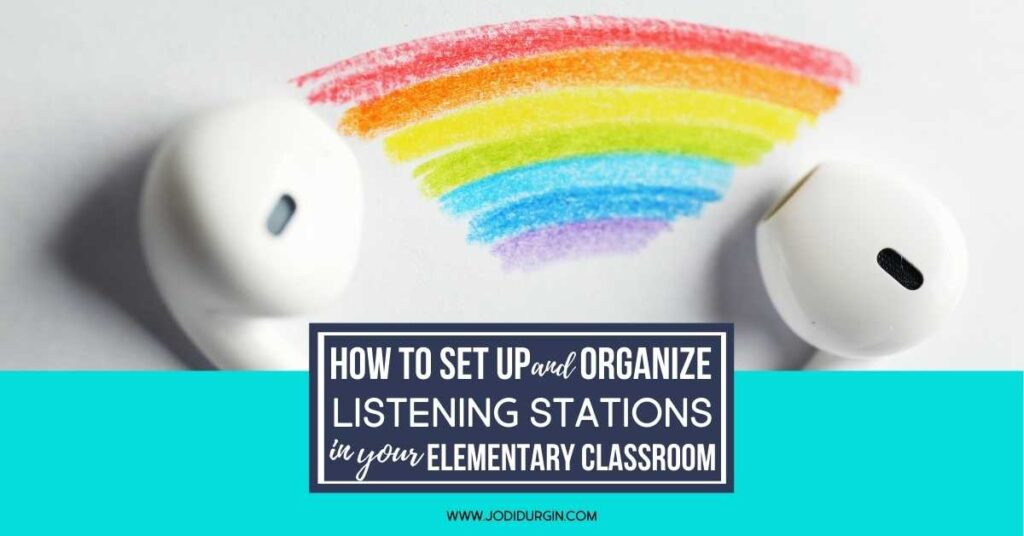Some teachers think that listening centers are just for kindergarten, first, and second graders; however, the older kids love listening centers too! Students of all ages benefit tremendously from listening to texts being read aloud. This post shares information about listening centers, as well as tons of ideas for setting up listening centers in your classroom. You’ll get the listening center ideas you need to implement your very own system. Read below to scoop up tons of listening center ideas!

What is a Listening Center?
A listening center can take many forms, but they all involve students listening to a story being read to them while they follow along with the book in front of them. You can use iPads, iPods, MP3 players, desktop computers, laptops, cd players, and even cassette players. Listening centers are also often called a listening stations,
What is the Purpose of a Listening Center?
The purpose of a listening center is to provide regular opportunities for students to listen to texts read aloud to them. These experiences help build reading fluency and a love of books and reading.
How to Set Up a Listening Center in Your Classroom
Below are steps to take to successfully set up a listening center in your elementary classroom. Each step is packed with helpful listening center ideas!
1. Identify Technology Tools and Supplies You will Use
The first step for setting up a listening center is to identify what technology you are going to use for your listening center. Some examples are desktop computers, laptops, iPads, and iPods. You can go retro with CD walk mans, CD players, and cassette players. As part of this process, think about if the devices will need batteries, chargers, or to be plugged into an outlet. That will be very important for making sure you have all of the tools you need and also for picking a location in your classroom.
In order to listen to the story and not disrupt the rest of the class, you may find it helpful to have students wear headphones or earbuds. If your school does not supply these resources, then consider asking students to bring in a pair as part of their supply list for the beginning of the school year.
Next, consider what text formats you are going to offer in your listening center. You will need to determine if students will view the texts on technology devices or as hard copies. It’s best for each child to have their own copy of the book, but you can decide if having a digital copy or hard copy is best for you and your classroom. If you are opting to stick to a digital copy, how will students access these? Some popular examples are using iPads and QR codes, RAZ kids on a laptop, and www.Tumblebooks.com on a desktop computer.
2. Choose a Location
The second step of the process of setting up a listening center in your classroom is to choose a location. Will your listening center be in your classroom or in a separate area (e.g. library)? Most teachers opt to keep it in their classroom.
A few key factors when choosing a spot in your classroom are WIFI strength, outlets, and visibility. Let’s talk about WIFI strength first. It is very common for certain parts of the classroom to get better WIFI than others. If you are relying on wireless internet access in order for your listening center to work, then it’s important to do some test-runs before settling on a location. The second factor I mentioned was outlets. If the technology devices you are using for your listening center require outlets, then be sure to take this into consideration when selecting a location. You won’t want wires extending across the room as it’s a safety issue. Finally, you’ll want to make sure you are able to see the students working in your listening center from your small group table. This will significantly reduce off-task behavior.
3. Establish Organization Systems
Now that you know what technology and supplies you have and where in the room your listening center will be, it’s time to establish some organization systems. How will you organize the materials? How will you store them? Some popular storage solutions are baskets, bins, shelves, and Ziploc bags. If you are using hard copy books and tapes or CDs, you may consider storing them in gallon sized Ziploc bags and then putting those bags into a tub.
4. Create Expectations, Procedures and Routines
The next step for setting up your listening center is to take time to think about classroom management. For any task that students are doing independently, it’s important to think about strategies for ensuring students are on-task and learning. For example, one way to hold students accountable while they are working at the listening center is to incorporate a simple follow up activity for students to complete and turn in when they are done using the listening center. Another strategy for proactively managing student behavior is leading a class brainstorm about what the expectations should be for working in the listening center. Document the ideas on an anchor chart, transfer it over to a smaller poster, and post it in the area where the listening center is. Taking the time to brainstorm all of the hiccups that could happen and coming up with ways you can either prevent them from happening or manage them as they arise is worth the time investment.
Also as part of this step, write down the procedures and routines for how students will complete the listening center. It may be helpful to act out each of the steps students need to do to ensure you capture each step. Being very specific will help you better communicate the steps to your students. As you go through this process, brainstorm ways to make it easier for students so you can maximize student learning. For example, place stickers on the buttons they need to use. You can use a green dot for play, a red dot for stop and a yellow dot with an arrow drawn on it for rewind. The simpler, the better!
5. Brainstorm Ways to Build Up Your Listening Center Collection
The fifth step is to brainstorm ways to bulk up your listening center collection. Below are some ideas for how you can do it!
- Share with other teachers.
- Grab QR codes on Teachers Pay Teachers for your iPad. Some are even free!
- Borrow them from the school or public library.
- Get them free from Scholastic.
- Ask parent volunteers to make them for you. This is a great job for parents who work and can’t volunteer in the classroom. They simply need to record themselves reading the book with a turn signal at the end of the page. With computer technology they could do this in digital form or you can have them kick it old school with a tape recorder and a bell.
- Ask for donations! Families may have old discman’s tucked away in their basement or unused batteries laying around they would be happy to donate.
- Checkout local yard sales, online marketplaces, etc..
6. Prep Your Materials
Get ahead by prepping the materials for at least one month ahead. This will prevent you from having to scramble each week to find what you need.
7. Set Up Your Listening Center Area
Create a cozy spot in the location you chose for your listening center. Consider flexible seating options for this space. Head on over to Instagram or Pinterest for some inspiration!
8. Introduce the Space to Your Students
Woohoo! You have created a listening center in your classroom! The last step is to introduce the space to your students and explicitly teach the expectations, procedures, and routines. Provide lots of opportunities for students to practice and provide feedback as needed.
In closing, we hope you found these listening center ideas for your elementary classroom helpful! If you did, then you may also be interested in these posts:




